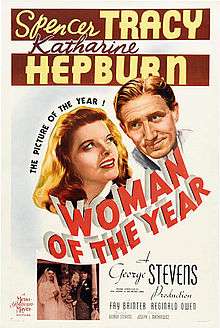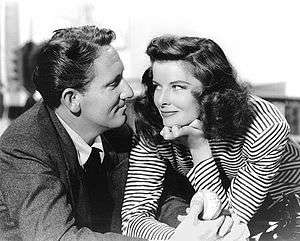Woman of the Year
| Woman of the Year | |
|---|---|
 movie poster | |
| Directed by | George Stevens |
| Produced by | Joseph L. Mankiewicz |
| Screenplay by |
Ring Lardner Jr. and Michael Kanin |
| Starring |
Spencer Tracy Katharine Hepburn |
| Music by | Franz Waxman |
| Cinematography | Joseph Ruttenberg |
| Edited by | Frank Sullivan |
Production company | |
Release dates |
|
Running time | 114 min. |
| Language | English |
| Budget | $1,006,000[1] |
| Box office | $2,708,000 (initial release)[1] |
Woman of the Year (1942) is an American romantic comedy-drama film starring Spencer Tracy and Katharine Hepburn, written by Ring Lardner, Jr., Michael Kanin and John Lee Mahin, directed by George Stevens and produced by Joseph L. Mankiewicz.
The film's plot is ostensibly about the relationship between Tess Harding, an international affairs correspondent, chosen "Woman of the Year," and Sam Craig, a sports writer, who meet, marry, and encounter problems as a result of her unflinching commitment to her work.
In 1999, this film was selected for preservation in the United States National Film Registry by the Library of Congress as being "culturally, historically, or aesthetically significant".
Plot

Tess Harding (Katharine Hepburn) and Sam Craig (Spencer Tracy) are journalists for the fictional New York Chronicle, with two drastically different backgrounds and worlds. Tess is an educated, well-travelled political affairs columnist who speaks several languages fluently. Sam is a knowledgeable and informed sports writer. Their difficulties are presented as stemming from class and emotional differences as well as from those of gender.
A feud in their columns erupts over baseball, and their editor tells them that he will not stand for an intramural feud at his paper. Sam invites Tess on a date to a baseball game, and she inadvertently breaks the "men only" atmosphere of the press box. She is confused and unfamiliar with the rules of the sport. Tess then invites Sam to her apartment later that night. What he thought would be a romantic occasion is actually a dinner party where none of the guests is speaking, or can speak, English. Despite the seemingly wide differences between their lives and personalities, the two fall in love.
After Sam and Tess marry, a conflict arises over Tess's priorities and Sam's place in her life. They have several minor disagreements about not being together enough, but a bigger problem occurs when Tess volunteers to take on the care of a Greek refugee child, Chris (George Kezas), without consulting Sam. Tess is excited but trepidatious about Sam's reaction. He initially believes Tess is pregnant when she announces they're having a child. Upon meeting Chris, however, he is angry and doesn't want an unrelated six-year-old orphan. Still, he tries to befriend the boy and introduces him to sports.
Tess learns that she has received the award of "America's Outstanding Woman of the Year", to be awarded at a gala ceremony. She plans to leave Chris by himself. When Sam finds out, he refuses to leave Chris alone, though Tess wants him to be beside her on her big night, and is embarrassed at the thought that the public will wonder where he is. Sam says she can tell everyone he had more important plans. Tess offends him by asking if anyone would believe he could find something more important to do. While Tess is at her ceremony, Sam returns the child to the orphanage and walks out on Tess. She learns of this upon her return home, when she goes to change for photographers – only to discover that Sam and Chris and their belongings are all gone. She attempts to reclaim Chris, but he refuses, preferring to stay with his fellow refugees.
The next day, Tess receives an invitation, addressed to both of them, to the home of her prominent Senator father (Minor Watson) and the world-famous feminist aunt who raised her (Fay Bainter). Sam is covering a championship boxing match that evening and tells her he cannot go. Tess arrives alone, only to be told that her aunt and her father are to be married that night, after 15 years of "making the same mistake" and saying nothing of their mutual attraction. Listening to the words of the wedding ceremony encourages Tess to attempt a reconciliation with Sam.
Tess enters Sam's Riverside home the next morning and starts to prepare breakfast. Eventually awakened by her noisy incompetence in the kitchen, he watches her surreptitiously. She proclaims her intention of being nothing more than his wife and thinking only of his domestic needs, but he believes it is an insincere tactic to win him back. Trying to prove herself, Tess once again tries to cook breakfast, only to fail because she knows nothing of cooking.
Sam tells her this is the first time he is disappointed in her, faulting her for going to extremes. He says he does not want Tess Harding or "just Mrs. Sam Craig," but instead "Tess Harding Craig." Tess happily agrees, and they reconcile. Gerald, Tess' ultra-competent secretary (Dan Tobin), arrives with a bottle of champagne and reminds Tess of her commitment to launch a ship. Sam takes Gerald outside, the bottle smashes, and Sam returns, claiming to have "launched" Gerald.
Cast
|
|
Background and production
The outline for the film was developed by Garson Kanin, a close friend of Hepburn's. Hepburn then passed the outline to Joseph L. Mankiewicz at MGM, and said the price was $250,000 – half for her, half for the script.[2] He liked it and agreed to produce the movie.[3] Kanin was fighting in the war at the time, so the script was written by his brother, Michael Kanin, and mutual friend Ring Lardner, Jr. Hepburn contributed significantly to the script – reading it, suggesting cuts and word changes, and generally providing helpful enthusiasm for the project.[4] As a part of the deal, Hepburn had the option of selecting her co-star and director (Tracy and Stevens).
Woman of the Year was the first of nine films Hepburn and Tracy made together. They met for the first time on the shoot. In the 1993 documentary Katharine Hepburn: All About Me, Hepburn herself says she was wearing high heels at the first meeting with Tracy and producer Joseph L. Mankiewicz, and said "I'm afraid I'm a bit tall for you, Mr. Tracy". Mankiewicz then responded, "Don't worry, Kate, he'll cut you down to size." It was during the filming of Woman of the Year that Hepburn and Tracy became romantically involved – a relationship that lasted until Tracy's death in 1967.
The film was originally shot with a different ending, but it proved unpopular at test screenings. The decision was made to change it, and the final fifteen minutes of the film were re-written and shot. The original ending of the film saw Sam go missing (after he had left the child at the orphanage) while he was meant to be writing an article about an upcoming boxing match. Tess decides to take over for him, and visits the gym to learn about the fight. Sam is found in a language school trying to learn French and Spanish, to "be important", and is shocked when he sees the article. He goes to the fight where he meets Tess. She insists that she did it to be a "good wife," and says she will change and do everything expected of her. He says that he doesn't want either extreme; he just wants her to be "Tess Harding Craig" (the same as in the released ending.)[5]
Ring Lardner, Jr. describes in Archive of America Television oral history interviews (2000) that changes made to the ending of the film were against the wishes of Katharine Hepburn, while both screenwriters were on vacation in New York. These changes were made by Louis B. Mayer, producer Joseph L. Mankiewicz and director George Stevens. "She had to get her comeuppance for being too strong in a man's world so they wrote a scene where she tried to fix breakfast ... and gets everything wrong", said Lardner. The screenwriters were given some room to rewrite the new ending on returning from New York, and in the same interview Lardner recalls "some of the worst lines we rewrote, but we couldn't fix it, we couldn't change it fundamentally".[6]
Reception
Box Office
The film earned $1,935,000 in the US and Canada and $773,000 elsewhere during its initial release, making MGM a profit of $753,000.[1][7]
Awards and honors
At the 15th Academy Awards, Michael Kanin and Ring Lardner, Jr. won the award for Best Original Screenplay, and Katharine Hepburn was nominated for Best Actress.
American Film Institute included the film in the 2000 list AFI's 100 Years...100 Laughs (#90)[8] and in 2002, in AFI's 100 Years...100 Passions (#74).[9]
In 1981, the movie was adapted into a successful Broadway musical of the same name, starring Lauren Bacall (who won a Tony Award for her work).
Gallery
References
- 1 2 3 "The Eddie Mannix Ledger". Los Angeles: Margaret Herrick Library, Center for Motion Picture Study{{inconsistent citations}}.
- ↑ Hepburn, Katharine (1991). Me: Stories of My Life. New York: Knopf. p. 400. ISBN 0-679-40051-6.
- ↑ Hepburn (1991), p. 243.
- ↑ Kanin, Garson (1971). Tracy and Hepburn: An Intimate Memoir. New York: Viking. p. 81. ISBN 0-670-72293-6.
- ↑ "Interview with Ring Lardner, Jr" (PDF). On Writing. The Writers Guild of America, East, Inc. 7. August 1997. Retrieved September 5, 2011.
- ↑ Archive of American Television - EMMY TVLEGENDS Ring Lardner interview 2000
- ↑ "101 Pix Gross in Millions" Variety 6 Jan 1943 p 58
- ↑ "AFI's 100 Years...100 Laughs" (PDF). American Film Institute. 2000. Retrieved August 21, 2016.
- ↑ "AFI's 100 Years...100 Passions" (PDF). American Film Institute. 2002. Retrieved August 21, 2016.
External links
| Wikiquote has quotations related to: Woman of the Year |
| Wikimedia Commons has media related to Woman of the Year (film). |
- Woman of the Year at the Internet Movie Database
- Woman of the Year at AllMovie
- Woman of the Year at the TCM Movie Database










